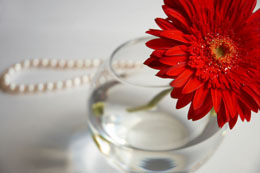Gerbera daisies stand for beauty and cheerfulness. This article provides information on how to take care of these gorgeous flowers.

These long-lasting flowers dramatically change the atmosphere of a room where they are kept in. The satiny petals surrounding the prominent center are so bright and attractive, that you don't need showpieces to enhance the beauty of a room. Gerbera was named in the honor of the German naturalist Traugott Gerber.
Gerbera belongs to the genus 'Asteraceae', which includes ornamental plants from the sunflower family. Approximately 30 species of Gerbera are found in the wild, in South America, Africa, and Tropical Asia. They are actually perennials. The foliage develops as a low mound of large, rich, green leaves. Because of their stunning beauty, they are considered as central elements in all types of flower arrangements, decorations, bouquets, etc.
The vibrant and bright colors of Gerbera flowers have made them quite popular. Here is a list of colors they are available in.
- Yellow
- Orange
- White
- Cream
- Red
- Pink
- Purple
- Lilac
- Brown
- Salmon
Thousands of cultivars varying greatly in shapes and sizes, are available these days. In most cases, a cross between Gerbera jamesonii and another South African species, Gerbera viridifolia, called Gerbera hybrida, is made available by gardeners. You must have also come across bi-colored flowers with a black center and multicolored petals. Bees, butterflies, and birds are attracted to these flowers because of their bright colors, creating a pleasant atmosphere in your garden.
How to Take Care of Gerbera Flowers
- Fertilizer: Blooming or actively growing daisies should be fed every alternate week with a water-soluble fertilizer.
- Temperature: The daisies grow well in average to cool temperatures. In warm conditions, they may stop blooming.
- Propagation: The daisies propagated from the seeds may require as long as 6 months to reach the blooming stage.
- Repotting: Gerberas grown in a greenhouse should be repotted in spring.
- Water: You should keep the daisies evenly moist when they bloom. When blooming season is over, they can be allowed to dry slightly, before watering.
- Light: They require lots of light to bloom for a long time. For this, they should be planted in a sunny location. Even additional artificial light can prove beneficial for them.
- Humidity: They require average humidity. In case of indoor planting, you may sprinkle water over the foliage 1-2 times a week during the winter, but avoid doing so on open blooms.
- Grooming: Gerberas don't need any grooming. Just remove the faded leaves, flowers, and stems. Do not apply any leaf shine products. Slightly hairy leaves of a Gerbera, resent being wiped.
- Soil: They grow comfortably in well-drained soil. You should use a high-quality peat-based potting soil for planting the daisies.
- Insecticides: Healthy daisies that receive full sunlight are usually not affected by pests. There are chances that poorly grown plants can be attacked by aphids, white flies, leaf spots, and spider mites. You are expected to read the instructions carefully before using insecticides.
- Flower Arrangement: To enhance the beauty of your room, you can always keep the Gerbera flowers in a vase in a cool corner of a room. Add a teaspoon of sugar to the water, or 2 drops of liquid bleach to a gallon of water, to increase the longevity of these flowers. You should trim the long stems of the flowers at an angle of 45 degrees, every day. Change the water in the vase, regularly.
Very young Gerbera daisies do not bloom. They bloom the longest when they receive strong light, proper fertilizers, and when kept evenly moist and warm. Very high temperatures can make them wilt, and very low temperatures can turn the leaves black. Watering it with cold water may let it develop dark patches on the leaves. Being too wet or too dry is not good for the plant. The leaves may turn brown and start drying up. Plants that are too wet, develop a crown rot that is fatal. A white mildew on the leaves means that the plant is being kept too cool with excessive moisture.
You should ideally buy a plant that is just beginning to bloom and has several buds. If all the conditions are favorable, Gerbera daisies may bloom for 6 weeks or more. As it begins to languish, you can plant it outside in your flower garden in a sunny location if it is early summer. In well-drained soil, they may bloom until frost appears.






 These long-lasting flowers dramatically change the atmosphere of a room where they are kept in. The satiny petals surrounding the prominent center are so bright and attractive, that you don't need showpieces to enhance the beauty of a room. Gerbera was named in the honor of the German naturalist Traugott Gerber.
These long-lasting flowers dramatically change the atmosphere of a room where they are kept in. The satiny petals surrounding the prominent center are so bright and attractive, that you don't need showpieces to enhance the beauty of a room. Gerbera was named in the honor of the German naturalist Traugott Gerber.